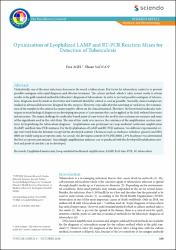| dc.contributor.author | Ağel, Esra | |
| dc.contributor.author | Sağcan, Hasan | |
| dc.date.accessioned | 2020-11-12T10:04:28Z | |
| dc.date.available | 2020-11-12T10:04:28Z | |
| dc.date.issued | 2020 | en_US |
| dc.identifier.citation | Ağel, E. ve Sağcan, H. (2020). Optimization of lyophilized LAMP and RT-PCR reaction mixes for detection of tuberculosis. The EuroBiotech Journal, 4(4), 230-236. https://dx.doi.org/10.2478/ebtj-2020-0027 | en_US |
| dc.identifier.issn | 2564-615X | |
| dc.identifier.uri | https://dx.doi.org/10.2478/ebtj-2020-0027 | |
| dc.identifier.uri | https://hdl.handle.net/20.500.12511/6020 | |
| dc.description.abstract | Undoubtedly, one of the most infectious diseases in the world is tuberculosis. Key factor for tuberculosis control is to prevent possible contagion with rapid diagnosis and effective treatment. The culture method, which it takes several weeks to obtain results, is the gold standard method for laboratory diagnosis of tuberculosis. In order to prevent possible contagion of tuberculosis, diagnosis must be made in short time and treatment should be started as soon as possible. Normally, clinical samples are studied in advanced laboratories designed for this purpose. However, especially after the screening in rural areas, the transmission of the samples to the centers has many negative effects on the clinical material. Therefore, the latest trend molecular techniques in microbiological diagnosis are developing into point of care systems that can be applied in the field without laboratory infrastructure. The major challenge for molecular-based point-of-care tests is the need to store polymerase enzymes and some of the ingredients used in the cold chain. The aim of this study is to increase the resistance of the amplification reaction mixtures by lyophilizing the tuberculosis diagnosis. Lyophilization was performed on Loop-mediated isothermal amplification (LAMP) and Real-time PCR mixtures. For the lyophilization of LAMP and RT-PCR mixtures, two different experimental setups were tried from the literature except for the developed content. Chemicals such as stachyose, trehalose, glycerol and PEG 8000 are widely using as cryoprotectants. As a result, the developed content (0.5% PEG 8000, 2.0 % Stachyose) was determined the best cryoprotectant mixture. Accordingly, amplification mixtures can be produced with the developed lyophilization method and point of care kits can be developed. | en_US |
| dc.language.iso | eng | en_US |
| dc.publisher | Sciendo | en_US |
| dc.rights | info:eu-repo/semantics/openAccess | en_US |
| dc.rights | Attribution 4.0 International | * |
| dc.rights.uri | https://creativecommons.org/licenses/by/4.0/ | * |
| dc.subject | Lyophilized Master Mix | en_US |
| dc.subject | Loop-Mediated Isothermal Amplification | en_US |
| dc.subject | LAMP | en_US |
| dc.subject | Real-Time PCR | en_US |
| dc.subject | M. Tuberculosis | en_US |
| dc.title | Optimization of lyophilized LAMP and RT-PCR reaction mixes for detection of tuberculosis | en_US |
| dc.type | article | en_US |
| dc.relation.ispartof | The EuroBiotech Journal | en_US |
| dc.department | İstanbul Medipol Üniversitesi, Sağlık Hizmetleri Meslek Yüksekokulu, Tıbbi Laboratuvar Teknikleri Ana Bilim Dalı | en_US |
| dc.identifier.volume | 4 | en_US |
| dc.identifier.issue | 4 | en_US |
| dc.identifier.startpage | 230 | en_US |
| dc.identifier.endpage | 236 | en_US |
| dc.relation.ec | info:eu-repo/grantAgreement/TUBITAK/SOBAG/1003 115R002 | |
| dc.relation.publicationcategory | Makale - Uluslararası Hakemli Dergi - Kurum Öğretim Elemanı | en_US |
| dc.identifier.doi | 10.2478/ebtj-2020-0027 | en_US |



















